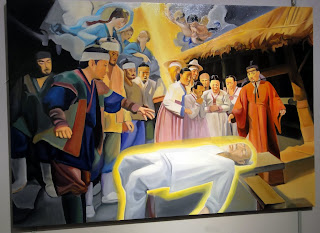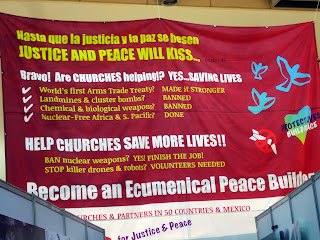 A 4 day colloquium sponsored by the Congregation for Institutes of Consecrated Life and Societies of Apostolic Life (CICLSAL) began today at the Augustinianum in Rome. This is one of the events prepared for the year dedicated to the Consecrated Life.
A 4 day colloquium sponsored by the Congregation for Institutes of Consecrated Life and Societies of Apostolic Life (CICLSAL) began today at the Augustinianum in Rome. This is one of the events prepared for the year dedicated to the Consecrated Life.One day will be dedicated to the religious life in the Catholic church, one day to religious life in the Orthodox churches and one day dedicated to the consecrated life in the Anglican and Protestant traditions. The last day the group will join with Pope Francis for the closing of the Week of Prayer for Christian Unity at the basilica of St. Paul's outside the walls.
Each day the participants gather for an ecumenical morning prayer based on this year's theme "Give me a drink". This then followed by a greeting from wither the Prefect of the CICLSAL or of the Congregation for Oriental Churches and the President of the Council for Chrostian Unity. The morning session concludes with a major presentation of the meaning of the consecrated life for each tradition (Catholic, Orthodox, or Reformed) and two testimonies give concerning the meaning of the vowed life and communal or fraternal living. The afternoon sessions are spent in sharing experiences and working on a final message to be issued at the conclusion of the colloquium.
 |
| Dom Joao Braz de Aviz, Prefect of the CICLSAL |
 |
| Fr. José Carballo, ofm, Secretary of CICLSAL |
An interesting statistic is the total number of consecrated persons in the various states of religious life totals approximately 756,385.
Archbishop Carballo emphasized three essential elements of consecrated. These include consecration, fraternal life in community and mission. The consecration underscores God's initiative and transforming relationship that the individual freely accepts. Rooted in baptism consecrated persons are called to holiness as are all the baptized. However, because of the vows that they freely pronounce there are "totally dedicated to God, loved beyond all things" (LG 44). The vows are primarily a gift of Christ, the Savior, in that they are fullness, love and freedom of the human person. The vows are grace, namely the Father's saving response in Christ through the Spirit to the most profound expectations of the human person -- to become everything for Christ, and through Christ, to his or her brothers and sisters in community, and with them, to all humanity.
Fraternal life in community is the true form of prophecy in the Church and the world, and must never be absent from consecrated life. Fraternal life in community has its roots in the God's paternity, which allows us to see his countenance in others, and, therefore, we can call them 'brothers' and 'sisters', and consider them as 'part of us'. To achieve this, fraternal live in community needs to be sustained by common prayer, by each one's freedom, and by the commitment of all the community members to continually build community. It needs to be a life based on dialogue and respect for every person. It needs to be a life that takes into account the gifts of each brother or sister and it needs to be marked by co-responsibility of each member to enliven fraternal life in community.
Lastly mission is one of the three founding and fundamental elements of religious life. Religious fully participate in the church's mission, and the latter, on her part, takes part in the missio Dei. Mission, more than a geographical movement is one of the heart.
These elements of the consecrated life may help others see how religious life has a definite ecumenical dimension. Since the consecrated life is centered on Christ its purpose it to go out of itself and people where their needs are the greatest. It is a concrete form of human dialogue which becomes a dialogue of communion, humble service, and an humanizing place.
 |
| Fr. José Maria Hernandez, CMF |
The second witness was given by Sr. Agnés Granier, RSA who spoke about the values of community life that lead to mission and the going out of oneself to where God's love is most needed.
Fr. Guido Dotti concluded the morning with a brief presentation of the Bose Ecumenical Community of men and women.
The afternoon session was held in working groups that discussed the morning's presentations and began working on a final statement. Catholic vespers were celebrated in the church of the Gesù. Tomorrow the program will concentrate on discovering Orthodoxy's forms of consecrated life,

















































